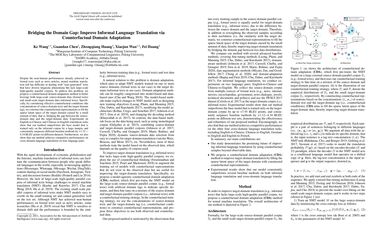Bridging the Domain Gap: Improve Informal Language Translation via Counterfactual Domain Adaptation
Despite the near-human performances already achieved on formal texts such as news articles, neural machine transla- tion still has difficulty in dealing with ”user-generated” texts that have diverse linguistic phenomena but lack large-scale high-quality parallel corpora. To address this problem, we propose a counterfactual domain adaptation method to better leverage both large-scale source-domain data (formal texts) and small-scale target-domain data (informal texts). Specifi- cally, by considering effective counterfactual conditions (the concatenations of source-domain texts and the target-domain tag), we construct the counterfactual representations to fill the sparse latent space of the target domain caused by a small amount of data, that is, bridging the gap between the source- domain data and the target-domain data. Experiments on English-to-Chinese and Chinese-to-English translation tasks show that our method outperforms the base model that is trained only on the informal corpus by a large margin, and consistently surpasses different baseline methods by +1.12 ∼ 4.34 BLEU points on different datasets. Furthermore, we also show that our method achieves competitive performances on cross-domain language translation on four language pairs.
PDF Abstract

